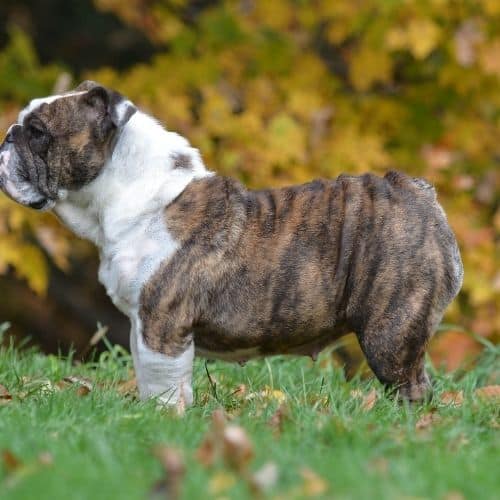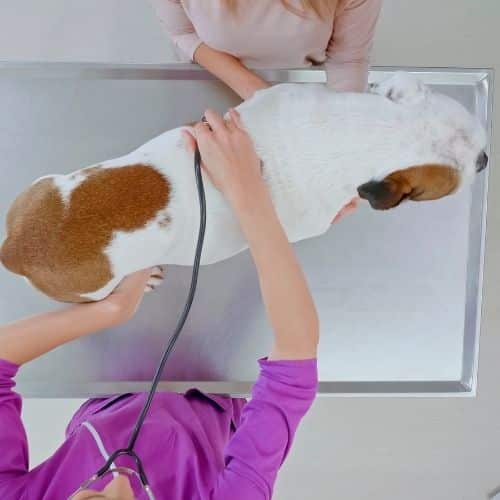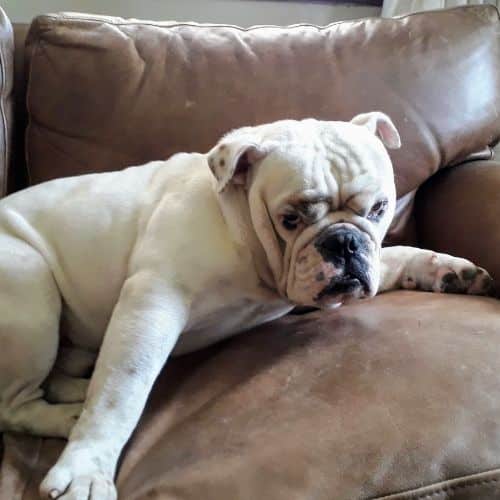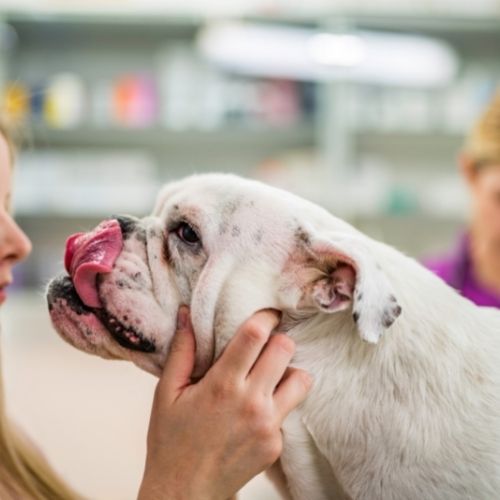Since English bulldog acts affectionately and calmly, most people love keeping them for pet purposes. Often, that bulldog you will find lying comfortably on the couch tends to be the English bulldog. One interesting thing is their tail. But, here are 4 English bulldog tail types you should know.
How many English Bulldog Tail Types are There?

The bulldog breed has several breeds, and the English bulldog will be one of them.
Although these other bulldogs, like the American bulldog, may have different types, the English bulldog has no other types. You will find only one kind of English bulldog.
You may, however, categorize these dogs according to their body features, like tails.
In this regard, let’s look at the different types of tails in the English bulldog. They may come in different shapes and sizes, even from the same litter.
These tail sizes and shapes get used by many people to tell English bulldogs apart. The tail exists as a short tail and may not get docked as some people may get tempted to think.
Docking bulldog tails may get you on the wrong side with the law of animal rights since it became illegal both in the US and UK.
If these two don’t practice docking, I bet it will be so in most other countries, especially where they have ties. So, if you see the corkscrew or stubby tail in an English bulldog, it will be natural.
What are the English bulldog tail types?

To answer this, yes, English bulldogs have tails when born. Although they may be very short, you will see them. The different types of tails in the English bulldog include:
- Straight tails– people often refer to this type as a pump-handle tail. The tails will be short and low hanging and taper down to a certain point. The American Kennel Club considers bulldogs with this type of tail as desirable. You will often find most English bulldogs with this type of tail, and it runs across all bulldog types. Don’t panic if you find the straight tail rising upwards with a higher set than other English bulldogs. Unlike the myths that these are faulty, they exist just like other natural tails in bulldogs and get very healthy for your English bulldog to possess.
- Long and wavy tails– some people often wonder if the English bulldog may possess a long tail. To your surprise, yes. Some English bulldogs get born with long tails. This phenomenon may get traced back to their breeding. If it was a crossbreed with a parent dog possessing a long tail, then the chances of having an English bulldog with a long tail get higher. Although very rare, you may find a pure breed English bulldog with a long tail. The wavy tails will also find their way in the English bulldog, with most breeders considering them to be faulty. Wavy tails may be healthier than corkscrew tails and make the dog wag easier.
- The corkscrew tails –these tails in the English bulldog breed wrap downwards to give a corkscrew shape. This tail type will be widespread among the English bulldog, just like the straight tail. In puppies, this tail type may be flexible. As the dog matures, the tail becomes stiff to form a bun-like shape.
- Curly tail– if your English bulldog has a curly tail, it will spiral loosely like a pig’s. Some people think it also curves back on itself like a Basenji’s. For breeders, this tail type gets less desired. They will avoid breeding litters with this tail type, and so you might not see an English bulldog with such a tail, although you may see one once in a while.
- For medical reasons, an English bulldog may be tailless– Although this doesn’t become genetic, and its descendants may have tails. Due to some medical conditions, the tail may get surgically removed and leave the dog without a tail. So if you ever saw one without a tail, this should explain it.
The explanation behind the English bulldog with a long tail

As we have seen, you rarely find English bulldogs with long tails. Some people find them funny, and some breeders refer to them as faulty.
Some people see long tails in the English bulldogs as abnormalities. But, this happens to be as natural as other tails. Certain factors may have contributed to a bulldog having a long tail. These include:
- Through crossbreeding
If an English bulldog got crossbred with another long-tailed dog, chances would be that the generation might have bulldogs with a long tail.
The bulldog has undergone many crossbreeding tests and experiments to bring out various traits. In the process, some develop long tails.
This scenario doesn’t make these bulldogs less. If there was a long tail gene somewhere along the line of an English bulldog, this gene might present itself later in the life chain of this English bulldog.
You will then have an English bulldog with a long tail.
However, crossbreeding hasn’t done the bulldogs much favor. Instead, it has altered their genetic variability [1], bringing about a weaker generation than the first English bulldog.
This gene variation has contributed to the long list of health issues [2] associated with the modern English bulldog.
By chance
Just like things happen in the world, you may have individuals with different characteristics from other similar individuals.
This way, you may get a pure breed English bulldog with a long tail. This scenario has a slight chance of happening, but it does happen.
However, we may trace it to the first breeding attempts to change the bulldogs from bull-baiting to other friendly bulldog types.
This attempt was good, but it gave birth to the various disorders [3] associated with the English bulldog and different bulldog tail types.
What are some of the English bulldog tail problems?

As we have seen various English bulldog types depending on their tail sizes and shapes, we also need to understand that these tails may develop health problems prompting their removal.
The corkscrew tails will be highly associated with most English bulldog type tail problems. Screw tails happen if there happens to be an abnormal development of the tail bones.
Although this may be a genetic abnormality, people have also deliberately introduced this possibility because they love the shape of this tail. The complications associated with the screw tails include:
Tail Fold Pyoderma in the English bulldog type
This condition comes about when the dog flushes its tail with its butt. The movement of the tail causes friction between these two places prompting inflammation.
The inflammation gets infected with bacteria due to the warm conditions between the tail and butt region. The infection may get treated with antibiotics but tend to recur for the same reasons.
The Spinal Column Malformations in English bulldog types
The screw tail English bulldogs exhibit two significant types of spinal column malformations. These two malformations include:
Spinal Bifida– this malformation happens when the spinal cord doesn’t get fully enclosed by the vertebrae supposed to do so.
This phenomenon consequently leads to not fully enclosing the crucial nerves in the spinal cord.
Thoracic Vertebral Canal Stenosis (CTVC) [4] – in this malformation, the vertebrae get malformed and squeeze the spinal cord in return.
This condition mainly affects young male English bulldogs and contributes to other health issues.
How to fix the English bulldog tail problems?
Antibiotics may help relieve the dog in the case of spinal Bifida. However, antibiotics don’t provide a lasting solution since the infections tend to recur.
Therefore, for the two conditions, the ultimate medical solution gets achieved by surgically removing the screw tails.
This surgery, scientifically known as caudectomy [5], helps fully cater to the discomforts and health problems associated with screw tail in the English bulldog type.
How should you care for your English bulldog’s tail region?

Due to the above concerns over the corkscrew tail, you need to properly take care of your English bulldog’s tail region.
Sometimes, these infections that affect the screw tail region may get avoided. In this regard, we provide you with a few tips that may help keep your four-legged friend infection-free.
- Clean the dimpled area below your dog’s tail.
- Use unscented wipes or wet cloth to wipe the debris and gunk below the tail.
- Use a towel or dry absorbent tissue to dry the wiped region dry
- Develop a routine to clean the area below the tail with warm water daily and dry with a towel or absorbent tissue
- Visit your veterinary doctor if the butt region has a foul smell and seems irritated or inflamed
Is it possible to find old English bulldogs with a tail?

We have seen various reasons that result in tail removal in most bulldogs. It will not be abnormal for the English bulldog type to find no old English bulldog with a tail, especially if they had the screw tail.
The tails don’t pose a significant health risk when they are littered. But as these dogs grow and mature, environmental factors play an essential role in their lives.
They may tend to get more sweaty under their tails as they gain weight. This sweating may trigger infections in most of the screw tailed English bulldog types and hence get their tails surgically removed.
So, yes, you may find old English bulldogs with tails, but you may also get old ones without tails.
Related: Why Don’t Corgis Have Tails
Is it legal to cut an English bulldog tail?
Tail docking has become illegal in most countries of the world. Docking involves a medical procedure where you cut off a dog’s tail, either short or completely removed.
Initially, working dogs had their tails docked to limit distractions. When taxing on non-working dogs started, some people could dock their docks to avoid the taxes.
As times changed, docking was illegal in most countries, especially if you needed to dock your dog for cosmetic purposes.
You will only be allowed to cut your English bulldog tail for medical reasons and if your veterinary suggests so.
As we have seen, this procedure gets carried out mainly in screw-tailed English bulldog types. The tail gets cut to avoid health issues associated with bacterial infections [6].
Is it dangerous to cut an English bulldog tail?

Cutting your English dog’s tail might be dangerous, even if cutting it for medical reasons. The following dangers should prevent you from having your English dog’s tail cut, especially if you were doing it for cosmetic reasons.
These reasons also played a big role in banning dogs’ traditional tail cutting practice.
- The wound that results from docking may get infected with bacteria. Even when docking prevents recurring infections, it may lead to an infection if the wound doesn’t get the proper care. A bacterial infection on the wound may cause more suffering, so you should adhere to the post-surgery drug prescription by your veterinary surgeon.
The dogfighting sport though illegal, makes the participants dock their dog’s tails using crude methods.
The dog may die if an infection occurs since they don’t put them on medication as per ASPCA report [7]. Due to the cruelty of the sport, it should be condemned and stopped.
- The wound will be painful for days or even weeks before it recovers. If the dog doesn’t get the desired treatment, this pain may be unbearable even to the dog.
- If not done right, docking may cause excessive bleeding and death. Some nerve damage may also occur in the surgical area, causing the dog more suffering. So, as much as the docking procedure may save a dog’s life, it should be avoided by most dog owners, especially for cosmetic or illegal sports purposes.
Read Also: White Spot on Dog Nose
Final thought
The English bulldog has no other types but exists as a single bulldog type. However, the English bulldog breed may be categorized using their tail shapes and sizes.
Their short tails don’t necessarily mean they have gotten docked.
But, under medical conditions, docking may be approved to the English bulldog type.
If you have one or intend to buy one, ensure you keep the tail region clean to avoid bacterial infection, which may lead to docking.
Read Next: New Dog Introduction